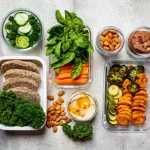
Ah, those newbie gains! That’s something you’ll never experience again if you’ve been regularly lifting for at least 1-2 years.
That right there is where you are going to see drastic changes in the way your body transforms. You can literally see yourself making progress each time you get to the gym.
The sad part is that most guys and gals have no clue about it and are not taking full advantage of it. In your first year of training, your body will respond really fast to resistance training.
You will be able to build muscle at a faster rate and moreover, you will be able to do it while losing fat as well. How cool is that?
So if you are in that position right now, this article will go right down your alley. We’re discussing how you can make the most out of your beginner gains by following just 5 stupid-simple steps. Trust me. You are going to thank me for this.
In your first year of training, if everything is in check, you can build up to 20 pounds of solid muscle mass. That’s around 40% of all the muscle you will build in your entire life, considering you are doing it naturally.
Here’s how to make the most out of it.
1. Don’t cut back on calories
This is the top mistake I’ve seen both guys and gals did. Most people start working out and get active because they want to lose weight?
So it makes perfect sense to eat less or at least try to stay on top of your diet, right?
Well, yes and no. As I was telling you above, as an untrained beginner you are in a privileged position. Meaning that you will be able to build muscle and lose fat at the same time.
Later on, you will not be able to do that anymore unless you are using steroids or other shady substances. Chances are you are not going to go down that road, so hear me out.
Yeah, at a later stage you will need to cut back on calories when you want to lose fat and eat more when you want to bulk up. But for now, you don’t need to take that approach to get a body like Cody Calafiore or Ben Booker.
Muscle growth and gaining strength happen when you are in a mild caloric surplus. That’s just how our bodies work. If you are eating fewer calories than your body needs your progress will be hindered by your diet.
Here’s how to make sure your diet doesn’t stay in the way of your progress.
First and foremost try to estimate your body fat percentage. The quickest and cheapest method is to use a caliper. If you are over 25% body fat, you will indeed need to cut back on calories until you get to 12-15%.
Do it by reducing your caloric intake by 25%. This will maximize fat loss. You should be losing around 2 pounds of fat each week which will mean that you will reach your desired weight in about 10 weeks or so.
If you already are at 12-15% body fat, or if you just got there, you will need to eat at a maintenance level or a slight caloric surplus of just 5-10% over your maintenance level.
So eat an extra 200 kcal each day, train hard and you will see progress.
2. Keep an eye on the macros
Taking things one step further, you want to look at where your calories are coming from. Getting the right amount of calories is super important, but you also need to look at things such as proteins, carbs, and fats in check as well.
This might sound like a daunting task at first, but once you get used to it it’s not so hard anymore. On top of that, nowadays you have a ton of apps that do most of the job for you anyway. So you have no excuses.
The building blocks of muscle fibers are amino acids which are coming from protein. That’s why everybody in the fitness industry is obsessed with protein intake. Don’t worry though; you will not need to eat crazy amounts of meat to get enough protein.
If you manage to have around 25% of your calories coming from protein sources that will be totally fine. If you do the math, for a 2,500 kcal diet, that’s around 150-160 grams a protein a day, which is doable.
Carbs are equally important. Yeah, I know there’s a big hype around low-carb diets nowadays, but if you are a healthy, active individual you are going to need plenty of carbs in your diet.
Carbohydrates are used by our bodies to fill the muscles with glycogen – which acts as the primary source of energy when we train.
So eating plenty of carbs will supply enough glycogen and energy to go through those heavy and intense workouts.
You can have up to 50% of your calories coming from carbs. Try to eat more of the complex, unprocessed carbs such as sweet potatoes, rice, beans, fruits, and veggies, rather than simple carbs and highly processed foods.
Last but not least, you want to have a decent amount of fats in your diet. Fat doesn’t have a direct role in muscle growth, except maybe the fact that it may boost testosterone production.
However, fat is super important for keeping things running smoothly at a hormonal level and also for keeping your skin, hair, and joints in good condition.
So fill up the rest of your calories with healthy fats sources such as nuts and seeds, avocado, or fish.
Alright, so that’s all there is to know about nutrition, in a nutshell, to get you started on the right foot. Of course, this is an oversimplified explanation of how everything works, but it will do for the purpose of this post.
You are welcome to read more about dieting and nutrition if you want to expand your knowledge. Moving on, we are getting to the fun part – training.
3. Focus on compound movements
You may know by now that there are compound movements and isolation movements.
Exercises such as squat, bench press, deadlift, pull-ups, or shoulder press target more muscles and use several joints, and are referred to as compound movements.
On the opposite side, an exercise that focuses on a single muscle group and uses only one joint is called isolation movements. Here you have stuff such as the bicep curls, trip extension, or leg curls.
It has been scientifically proven that compound movements will recruit more muscle and will give you much better results when it comes to muscle hypertrophy.
First and foremost, by using more muscle groups instead of just one, compound movements will allow you to work out using much heavier weights which is optimal for muscle growth.
Don’t get me wrong, isolation movements still have their place in a workout and shouldn’t be disregarded. But, compound movements are superior.
I’d say that if you spend 80% of your time and effort on doing compound movements and the rest of 20% on isolation exercises you should be fine.
A good approach is to perform your compound movements first, at the beginning of your workout when your energy levels are up and you are not tired.
Then at the end of your workout do 1-2 isolation exercises to finish off the muscles or to get in more volume.
Compound movements will also burn more calories which makes them perfect for getting into a caloric deficit and losing fat easier.

4. Progressive overloading
This is a fancy term that gets tossed around quite a bit in the fitness and bodybuilding industry. The meaning behind it is very simple though.
The progressive overloading training technique means that the goal of your workout routine is to constantly get stronger and stronger, by progressively using heavier weights, which will eventually result in better-developed muscles.
There’s a reason why the biggest guys in the gym are usually the strongest as well. So, if you want to make the most out of your newbie gains, your main objective is to lift heavier each time you hit the gym.
As a beginner, you literally can do that. If you never trained before, the progress you will be making will be so rapid that you can actually get stronger each and every workout.
But you will need to challenge yourself to do that. You will need to get out of your comfort zone and don’t be afraid to add more weight to the bar even when you don’t really feel like it.
With progressive overload, you increase the difficulty of your training and as a result of that, your body will adapt to that stimulus while it recovers. That’s why it is super important to live a balanced life, get enough sleep, avoid stress, and eat right.
There are many ways to implement progressive overload. The most common one (and the one which works best if you ask me) is to simply increase the weight you are using on a specific exercise.
Another thing you can do is to increase the number of sets and reps you can do. But you want to stay in the 6-12 rep range, also known as the muscle hypertrophy range.
Some athletes prefer to keep everything the same – same weight, same exercises, same number of reps and sets – and increase the training frequency while decreasing the rest time. Anyways, there are tons of ways to put your body under more stress.
As a beginner though, if your main goal is to gain more size, your best course of action would be to increase the weight you are using, while staying in the 6 to 12 rep range, like mentioned before.
Once a weight becomes too easy for you and you can perform 12 reps with it, add more weight and start over. And so on and so forth.
5. High-Intensity Interval Training
I’m not a big fan of cardio training. I think it’s great for your overall cardiovascular conditioning and obviously, it’s beneficial if you are looking to boost your endurance.
But other than that, I think it’s too time-consuming and it can interfere with your workouts if your main goal is to build muscle.
Yet, I see so many newcomers are on the treadmills non-stop and then they wonder why they look like a marathon runners (no disrespect to marathon runners). What’s up with all that?
So, if you do need to do cardio, your best pick would be any kind of high-intensity interval training.
It’s quick, it is effective and it will give you to best bang for your buck. You will burn more calories in less time and your body will undergo a so-called “afterburn effect” which will heighten your caloric consumption even after you are done with your cardio training.
So instead of just jogging or incline walking on the treadmill do some sprint drills instead, or anything else which is high intensity.
But always have your cardio workouts after your weight training session or on your rest days. This way you will use most of your energy on the weights, you will move more weight and you will see better results in terms of muscle growth.
Conclusion
There you have it guys and gals – your 5 step guide for making the most out of your beginner gains. Train hard but also train smart. Do the right exercises, apply the right training technique, and then allow your body to recover.
Eat a diet that supports your workouts and always tries to improve your performance. That’s all there is to it really. There are no secrets and no shortcuts, just hard work, and passion.
About The Author:
Tyler has been working as a certified personal trainer for over 10 years specializing in weight loss and functional training with women between the ages of 30 – 65. He also enjoys helping others become industry-leading personal trainers through his website PTPioneer.com and YouTube Channel.



![How To Train Your New Puppy [6 Effective Tips] How To Train Your New Puppy](https://www.safeandhealthylife.com/wp-content/uploads/2023/09/How-To-Train-Your-New-Puppy-150x150.png)
